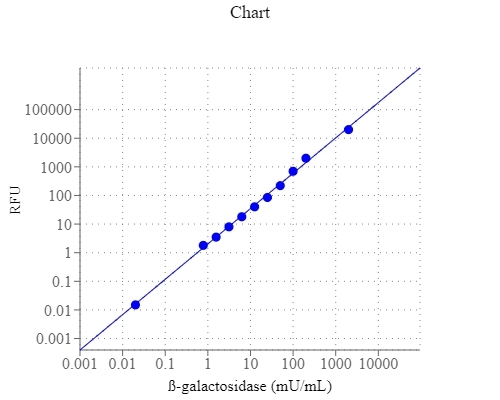Amplite® Fluorimetric Beta-Galactosidase Assay Kit
Red Fluorescence
E. coli beta-galactosidase is a 464 kD tetramer. Each unit of beta-galactosidase consists of five domains, the third of which is the active site. It is an essential enzyme in cells. Deficiencies of this enzyme can result in galactosialidosis or Morquio B syndrome. In E. coli, beta-galactosidase is produced by the activation of LacZ operon. Detection of LacZ expression has become routine to the point of detection of as few as 5 copies of beta-galactosidase per cell. This kit uses a red fluorogenic galactosidase substrate that can sensitively distinguish LacZ+ from LacZ- cells. The non-fluorescent substate generates a strongly fluorescent product upon reaction with galactosidase. It can be used either for detecting galactosidase conjugates in ELISA type assay systems or for monitoring LacZ gene expression in cells. Amplite® Fluorimetric Beta-Galactosidase Assay Kit comes with all the essential components with an optimized assay protocol. It can be used with a fluorescence microplate reader, a fluorescence microscope, or a flow cytometer. It might also be used for screening galactosidase inhibitors or inducers.


| Catalog | Size | Price | Quantity |
|---|---|---|---|
| 12603 | 200 Tests | Price |
Spectral properties
| Absorbance (nm) | 570 |
| Extinction coefficient (cm -1 M -1) | 65000 1 |
| Excitation (nm) | 571 |
| Emission (nm) | 584 |
| Quantum yield | 0.75 1 |
Storage, safety and handling
| H-phrase | H303, H313, H333 |
| Hazard symbol | XN |
| Intended use | Research Use Only (RUO) |
| R-phrase | R20, R21, R22 |
| UNSPSC | 12352200 |
Instrument settings
| Fluorescence microplate reader | |
| Excitation | 540 nm |
| Emission | 590 nm |
| Cutoff | 570 nm |
| Recommended plate | Solid black |
Contact us
| Telephone | |
| Fax | |
| sales@aatbio.com | |
| International | See distributors |
| Bulk request | Inquire |
| Custom size | Inquire |
| Technical Support | Contact us |
| Request quotation | Request |
| Purchase order | Send to sales@aatbio.com |
| Shipping | Standard overnight for United States, inquire for international |
Page updated on December 14, 2025

